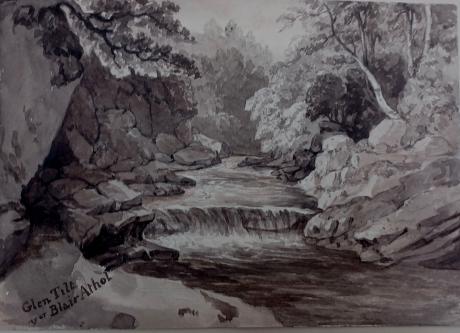inscribed " Glen Tilt near Blair Athol" a page from an album inscribed in the frontispage "F W Staines 3 Uplands St Leonards on Sea"
Amelia Jackson, Nee Staines (1842 – 1925) and thence by descent
Glen Tilt (Scottish Gaelic: Gleann Teilt) is a glen in the extreme north of Perthshire, Scotland. Beginning at the confines of Aberdeenshire, it follows a South-westerly direction excepting for the last 4 miles, when it runs due south to Blair Atholl. It is watered throughout by the Tilt, which enters the Garry after a course of 14 miles, and receives on its right the Tarf, which forms some beautiful falls just above the confluence, and on the left the Fender, which has some fine falls also. The attempt of George Murray, 6th Duke of Atholl to close the glen to the public was successfully contested by the Scottish Rights of Way Society in 1847.The massive mountain of Beinn a' Ghlò and its three Munros Càrn nan Gabhar (1129 m), Bràigh Coire Chruinn-bhalgain (1070 m) and Càrn Liath (975) dominate the glen's eastern lower half.
Marble of good quality is occasionally quarried in the glen, and the rock formation has long attracted the attention of geologists.
A chronicle written by Robert Lindsay of Pitscottie in the 1570s describes a banquet prepared by the Earl of Atholl for James V to impress a Papal ambassador. This event seems to have taken place in 1532 in a temporary wooden lodge built like a castle in Glen Tilt. The lodging was burnt at the end of the event. Mary, Queen of Scots visited Glen Tilt in August 1564, and wrote a letter from the "Lunkartis in Glentilth" to her ally Colin Campbell of Glenorchy.
James Hutton, the pioneer geologist, visited the glen in 1785 and found boulders with granite penetrating metamorphic schists in a way which indicated that the granite had been molten at the time. This showed to him that granite formed from cooling of molten rock, contradicting the ideas of Neptunism of that time that theorised that rocks were formed by precipitation out of water. Hutton concluded that the granite must be younger than the schists. This was one of the findings that led him to develop his theory of Plutonism and the concept of an immensely long geologic time scale with "no vestige of a beginning, no prospect of an end."
Sir John Clerk of Eldin visited the site and produced geological drawings of the area, immediately upstream of the old Dail-An-Eas Bridge which has since collapsed but the abutments remain as a listed building.
gallery
Hutton's locality at Glen Tilt
-
Hutton's Locality. It was from the Dail-an-eas bridge which used to span the river at this point that James Hutton found the evidence he was seeking that molten granite had intruded the country rocks. Location:
-
Hutton's Glen Tilt geological exposure at collapsed Dail-an-eas Bridge upstream from Forest Lodge, drawn by John Clerk of Eldin in 1785. Location:
-
Watercolour image by John Clerk of Eldin of the key exposure at Glen Tilt. The flow direction of the river is towards the top of the image, in a southwesterly direction. The rectangular areas at the top of the image are the foundations of the collapsed bridge.
Francis William Staines was the last of a family of merchants from the City of London. Not only was he a successful businessman but he possessed a large independent fortune, such that he could devote his time to the cultivation of his talents in music and art. He was a brilliant amateur violinist, and also loved to spend much of his time painting. His daughter Amelia and her mother accompanied Mr Staines as he travelled throughout the country finding subjects for his painting. One area of the country that they visited frequently was Scotland and the Lake District, and Amelia grew particularly fond of the dramatic landscape of the Fells. Skelwith Bridge with the view of the hills around it 43 was one of her father’s favourite scenes. He painted landscapes and maritime paintings , exhibited 11 works at the RA including views on the Italian Coast, address in London, Hastings and St Leonards on Sea Susssex.




